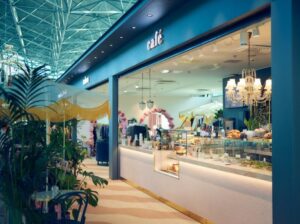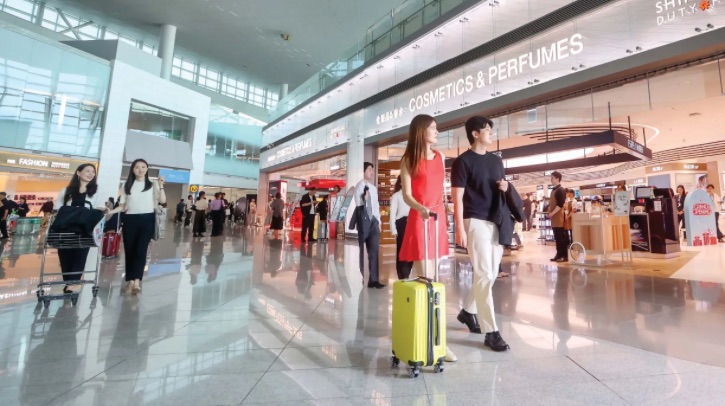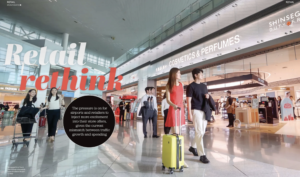The pressure is on for airports and retailers to inject more excitement into their store offers, given the current mismatch between traffic growth and spending.
Experience retailing has well and truly landed across the world’s international airports. The scale of branded pop-ups and promotional activities at these gateways is getting bigger, as Passenger Terminal World magazine has previously reported, and the shops themselves are becoming more impressive with every passing year.
One reason for the surge in large-scale promotions was a post-Covid drive from brands for market share. That has settled down somewhat, but a more important factor is at play: although 85% of flyers made purchases at airports in the past 12 months (according to an Ipsos survey for ad firm JCDecaux), they are spending less. Could it be that passengers are not all that enamored by the retail offers they are finding?

A study from global management consultancy Kearney, commissioned by the Tax Free World Association and released in October 2024, manifests the industry’s worst fears. While passenger growth in 2023 hit 30%, travel retail sales limped forward at only 18%. Moreover, the average value of the items purchased decreased by 20-30% over the 12 months.
This follows a steady decline in spend per pax since 2020 (see chart). In 2023 it dropped to US$16 per head, marking a low that surpasses the CAGR of 17.5% seen between 2009 and 2018, a period hit heavily by the global financial crisis.
“Our retail has been organically adapted with a lot of local touches”
Nora Immonen, Finavia Corporation
Lagardère Travel Retail’s latest results show nine-month 2024 sales growth of 12.8% (like-for-like) although the third quarter ending September was slower, at 11.7%. Asia-Pacific was a factor, with revenue down “due to lackluster activity in North Asia, which was held back by China’s economic slowdown”, the company stated.
In the first half of 2024, the world’s biggest airport retailer, Avolta, also saw a slowing quarterly trend: Q1 was up by 11.7% (organic) and Q2 by 8.7%.
Macro factors contributing to the slowdown in growth include more cautious buying due to high inflation, the end of post-Covid ‘revenge spending’, unfavorable exchange rates discouraging nationalities such as the Japanese and South Koreans from traveling, and economic weakness, notably in China.
As the Kearney study noted: “Travel retail’s price advantage is facing long-term erosion and, while enthusiasm for shopping in airports remains strong, behavioral patterns and expectations across generations of customers are evolving under new pressures.”

The strength of that enthusiasm to shop is debatable. Airports in Europe and the Americas need not be unduly concerned by the discrepancy in pax versus sales growth because the data is a little skewed this year. In 2024, there had been a first-half sales collapse in China’s Hainan downtown duty-free market, which had boomed during Covid, and this has depressed Asia-Pacific revenue.
The Kearney data reveals that Asia’s weakness was already apparent in 2023. Whereas Europe, the Americas, and Middle East/Africa were back to their 2019 levels with respective sales of US$21.6m, US$11.2m and US$7.2m, Asia-Pacific was way down by 30% versus pre-pandemic, at US$32.1m.
An experience economy
Experiences are seen as a way to improve the worrying per-pax spending change by increasing penetration. Airports admit that purchasing has been slowing. Formerly high-spending Chinese, while returning to international travel, are still not at pre-Covid levels in many global hubs, so there is a gap in the market.
At Finavia Corporation, which runs Helsinki Airport and other gateways in Finland, Nora Immonen, VP and director of commercial business, tells PTW, “Everybody is grieving for what the Chinese consumer was before the pandemic.”

Since then, Finavia has renegotiated most of its commercial contracts at the Finnair hub, both in retail and in F&B. The reality for Helsinki is that high-value international transfer passengers, many from Asia, have not rebounded well. Last year, their numbers hit 2 million, well below the 3.6 million seen in 2019.
“Our retail has been organically adapted with a lot of local touches,” explains Immonen. Lifestyle, health and the environment now play their part in a retail renewal that better reflects core passenger groups.
A good example is the second-hand Relove store – a ‘slow fashion’ brand founded by entrepreneur Noora Hautakangas, which has an experience-focused hybrid retail and café concept. “It is known to Finns because one vintage shop has turned into a chain,” says Immonen. “At the airport, the products are unique and the store creates added interest.”
“Since the pandemic there has been a shift from business to leisure travel”
Hazel Catterall, Newmark Group
Within the global travel services business of commercial real estate giant Newmark Group, Hazel Catterall, a director at the UK division, comments, “Since the pandemic there has been a shift from business to leisure travel. This change has a big impact on how people shop, with leisure travelers more likely to want great experiences.”
With Newmark’s help, Fraport, the operator of Frankfurt Airport, has been planning the retail offer for the new Terminal 3. Nina Kristin Gür, vice president of retail key account management, says, “We are not seeing the same growth divide as the Kearney study, but spending in duty free is not picking up as fast as in other areas. It could be because the cost to travel (flights and hotels) has risen. Nevertheless spending is more or less where we want it to be.”
Fraport has seen changes in certain categories, with perfumes and cosmetics (P&C) proving to be more difficult. Both the operator, Frankfurt Airport Retail, and the airport are targeting a broader mix of nationalities and consumer segments, and addressing changing passenger demands. “For example, the various groups of Chinese traveling today are behaving differently,” says Gür.
“Spending in duty free is not picking up as fast as in other areas”
Nina Kristin Gür, Fraport
Airport operators in South Korea know this only too well. Duty-free retailers like Shilla, Lotte and Shinsegae are suffering from the dearth of Chinese travelers and have stepped up price promotions and in-store activity to incentivize purchasing from Koreans and from younger cohorts in general.
At Incheon’s Terminal 2, Shinsegae recently unveiled upscale fashion and beauty stores spanning 2,100m2. The space caters to free independent travelers (FITs) and offers more interaction, such as product testing, sampling and social media opportunities. To celebrate the opening, customers spending over US$100 received a ₩10,000 (US$7.25) Starbucks card. The coffee retailer has a store in the immediate vicinity.
Gen Z are coming
Shinsegae’s more experiential store is part of a trend in mature markets and necessary to keep Gen Z customers – meaning those born between 1997 and 2010, according to McKinsey – interested in shopping. This group will grow rapidly at airports in the next two decades, so their needs must be addressed.

They are, however, a difficult segment because they want genuine, novel experiences when they shop. According to consumer intelligence company NielsenIQ, Gen Z have three core characteristics. First, they are digital natives, never having known a life without instant access to information through technology – which they expect at airports. Second, they are values driven, demanding more authenticity, social responsibility and social values from brand owners and retailers. Finally, they are pursuers of personalization, requiring tailored experiences and products.
Airports are getting to grips with this. At Fraport, Gür says, “For any retail concepts, whether they are existing or new, we now expect a certain level of innovation and/or elevation so that the offer is not the same as at any other airport. We’ve taken this on as a challenge.” The move makes sense. With contracts running for at least five years but behavioral changes and generational shifts happening right now – and rapidly – airports have to act sooner rather than later.
Bringing something novel
Kearney estimates that the global travel retail industry reached US$72bn in sales in 2023. In addition to airports, this includes channels such as downtown duty-free shopping, cruise lines and border shops. Airports, however, are the cornerstone of the industry and are becoming more attuned to the Gen Z quest to find something unique.
One way to do this is by adding niche labels even though they may not be able to offer the same margins to retail concessionaires as the big portfolio players. But in the current climate, airport retailers are willing to take the risk and experiment a little more to lift conversion rates.
“As a smaller brand we are seeing more support and more space. Travel retailers are really behind us now,” says Daniel Szor, the founder of Cotswolds Distillery in the UK. The company’s gins and whiskies are now well represented in British airports, with some lines that are exclusive to the channel. Szor says there has been a different approach from airport retailers since Covid.

Niche brands, especially those with a distinct sense of place – the name ‘Cotswolds’, for instance – are having their moment, while big international brands are trying to be more innovative, especially in the drinks segment. In Cotswolds’ case, Szor is also targeting locations where English-made products count for something – places such as Australia, the Caribbean and even Spain.
Portland Design, which has been active on numerous airport projects such as New York’s Newark Liberty Terminal A and London Luton Airport, believes new approaches are long overdue. Managing director Ibrahim Ibrahim says, “From data and research, as well as talking to our clients, we see that non-aeronautical revenue is not keeping up with passenger numbers. In some cases it is flatlining. This is a structural issue indicating something is seriously wrong.”
“The misalignment is between how the product is promised and the delivery of the experience”
Ibrahim Ibrahim, Portland Design
Portland sees a mismatch between what passengers are expecting – driven by changes in retail in the outside world, which condition customers – and what they find at the airport. “With rows and rows of indistinct bays and gondolas set around a convoluted walk-through, you see people wander past and not buy anything,” reports Ibrahim.
He notes that the added value is also often missing. “If I pick up something that is exclusive to an airport – which is the way things are going – I don’t then want to queue to buy it like you would at a supermarket. The misalignment is between how the product is promised and the delivery of the experience.”
He also points out that the spaces where luxury offers are present in duty-free do not live up to downtown department stores such as El Corte Inglés, Selfridges or Galeries Lafayette, especially in beauty and other luxury categories. “This does not align with customer expectations,” he says.
Different categories can also look the same despite consumer mindsets being very different in the P&C section compared with wine and spirits. Ibrahim says, “Portland prefers to forget about categories and look at different ‘universes’ that offer a change of pace and mood. The bits in between need to be activations, events, food and coffee. The idea of no food in the duty-free area is yesterday’s news.”
Heading toward hybridization
Design ideas are often constrained by space. Retailers have, however, taken Portland’s hybridization point on board, with concepts seeping into the market. Relove is one example of an independent doing it, but Smartseller, the joint venture between travel retailer Gebr. Heinemann and Casualfood, is another.

Their hybrid concept is specifically for airports with smaller commercial areas. Initially launched in Slovenia’s Ljubljana Airport in mid-2021, it also rolled out into Germany’s Albrecht Dürer Airport Nuremberg earlier this year.
On a bigger scale, Avolta has been working on hybridization at airports around the world, including Tianhe Airport in China, Bangalore in India and Bali in Indonesia. The move seemed almost inevitable as the company merges two businesses: travel retail heavyweight Dufry and travel F&B player Autogrill. Both were combined late last year to create the commercial travel retail powerhouse that is now Avolta.
Within retail itself, blended stores are also emerging. WHSmith has begun to extend its reach by adding wellness and beauty to the traditional convenience-store mix. Lagardère has done something similar with its Relay brand, by widening the category offer and becoming a one-stop shop for essentials. It has just expanded at Zagreb Airport in Croatia and Almaty Airport in Kazakhstan with three stores in each.
Such moves look to be where several airports are heading as they seek out space-saving options that are also beneficial to passengers. Coupled with more engaging in-store activities, they will be hoping to turn around the industry’s declining spend per pax in the coming 24 months.
Sol De Janeiro: L’Occitane’s biggest-ever pop-up

In summer 2024, beauty player L’Occitane Group went all out to promote its 2021 acquisition, the skincare brand Sol de Janeiro, in travel retail. More than 100 airports were selected for the colorful campaign, with the highlight being a pop-up right in the center of the main seating area of London Heathrow’s Terminal 2.
Called Unleash Your Summer Self!, the 360° activation – the group’s biggest ever – included 18 UK airports, 49 in Europe, 19 in Latin America, 14 in North America, and four each in Asia- Pacific and the Middle East. “We are pushing the boundaries of what is possible in travel retail,” says L’Occitane Group’s managing director for global travel retail, Evelyne Ly-Wainer. “This is only the beginning.”
The Heathrow pop-up was extended until the end of October 2024 and was complemented, like the others, by a social media push on Instagram and Facebook, where Sol de Janeiro has 2.4 million and 360,000 followers, respectively. Hyper-local geo-targeting was also used to reach travelers during their pre-trip phases.
This article originally appeared in the January 2025 issue of Passenger Terminal World. To view the magazine in full, click here.


